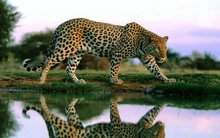| [Visitor (112.21.*.*)]answers [Chinese ] | Time :2022-01-03 |  The body length is 1-1.7 meters, the tail length is 0.7-1.0 meters, the healthy weight is about 60-100 kg, and the maximum weight can reach 130 kg. The body is slender, the limbs are short and powerful, and the claws are strong. The body length is 1-1.7 meters, the tail length is 0.7-1.0 meters, the healthy weight is about 60-100 kg, and the maximum weight can reach 130 kg. The body is slender, the limbs are short and powerful, and the claws are strong.
The head is larger, the neck is slightly shorter, the limbs are strong, the forelimbs are slightly wider than the hindlimbs, the forefoots are 5 toes, the hind feet are 4 toes, and the toes have gray-white sharp claws. There are short, thick hairs between the toes and between the palm pads of the toes.
Coat color: The head hair is short, and the end of the nose is bare and fleshy. The nasal hairs are extremely short and yellow with no dark spots on it. There are 5 rows of oblique white whiskers above the sides of the mouth. Small black spots are spread across the forehead, eyes, eyes and cheeks. The back of the ear is black, the tip of the ear is yellow, and the base of the ear is also yellow with sparse small black spots. The back of the neck is slightly darker yellow, with black spots and black rings, often with hairs in the center of the back of the neck. The underside of the neck is pale yellow, with several unformed black spots and slightly longer hairs. The forelimbs are brownish yellow on the outside and milky on the inside, with black rings on the shoulders and black spots on the inside and outside of the legs. The upper spots are large and sparse, and the lower spots are small and dense.The back is the darkest yellow, the central black ring of the dorsal ridge is not clear, the long black spots are arranged in a longitudinal line, the black rings on both sides of the dorsal ridge are mostly oval, and the black circles on the thorax and ventral side are round and plum-shaped. The thorax and abdomen are long, milky or yellowish in color, and there are a small number of large black patches on the top. The hind limbs are yellow on the outside, the medial side is pale yellow, the femoral area is black and black, and the inside of the tibial area is black-brown. The dorsal coat is dark yellow, the black spots near the base are striped, the central black spots are larger, some black spots form a circle, the end is black, and there are 2 to 4 narrow white rings on it. The underside of the tail is milky white with dark spots. The tip of the tail is white. There are more than ten white eyebrow whiskers on the eyes...
The iris of the eye is yellow. The pupil shrinks to a circle under strong light. Eyes can have phosphorescent sparkle at night.
The surface of the tongue has many small keratinized spines, which are inverted. There are 3 pairs of nipples under the abdomen.
There is a pair of glandular foramen in the folds.
Skull: Slightly longer skull shape. The snout is short. The nasal bone is long, and the nasal frontal process is several times the same length as the frontal process of the maxilla. The frontal bone surface is relatively flat, the posterior orbital process is blunter than the zygomatic orbital process, and the eye socket is rounded. The herringbone crest and sagittal crest of the adult beast are developed. There is a more pronounced occipital process in the center of the upper occipital bone. The occipital area is triangular in an equilateral shape. The auditory vesicles are long and tall, and the protrusions of the wing bones protrude backwards like hooks. The lower border of the lower jaw is slightly curved.
Teeth: The incisors are transverse, the central pair of incisors is smaller, the second incisor is slightly larger, and the outermost incisors are large and pointed. The canine teeth are well developed, sharp and conical. The first anterior molars of the upper jaw are absent, the second anterior molars are the smallest, and individuals are absent. The third anterior molars are "mountain" shaped, with a tall central tip and a small tip at the front and back. The fourth anterior molar (superior lobe) is the largest, with 5 tips, of which 4 are longitudinally lined with a line, and the second cusp is tall, with a lower cusp near the medial side. The molars are small, with only one, and the position is horizontal. There are only 2 anterior molars of the lower jaw, both of which are "mountain" shaped, with 3 tips, and the middle tip is the largest. The molars are large, in the shape of a "concave" glyph, with an almost equal-sized tip in front and behind it. |
|
